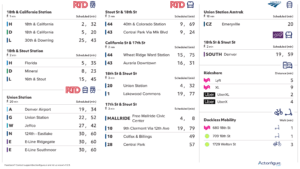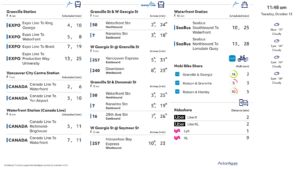The first and last miles of a commute can be the most challenging legs commuters face. Getting from home to the bus stop and vise versa is a major pain point for those who live farther out from transit options, leading commuters to opt to drive instead.

If they choose an option like taking a scooter to the office from the train station, they now need to figure out how to safely and responsibly park their vehicles once they are done. Leaving a bike locked to a lamp post isn’t a long term solution, and electric scooters can create clutter when parked irresponsibly. While bikeshare docks provide parking, keeping the sidewalks clear is an issue every city is facing.
To mitigate clutter complaints and improve the commuting process, cities are building mobility hubs on busy corners. These hubs bring public transit and micromobility to one central location while also providing safe parking for scooters and bikes.
Mobility hub basics
Mobility hubs are areas placed on city corners or at transit stops, keeping mobility and transit options in one place. They usually include a bus or metro stop, micromobility parking, as well as bike racks for residents who have their own bikes. More features like bike repair stations, shopping areas, and designated ridehailing drop-off locations can be added – depending on the size and location of the hubs.
First- and last-mile fixes
Mobility hubs provide many benefits to cities, commuters, and pedestrians. The main benefit is the sheer variety of mobility options available in one place. The first and last miles of a commute can be the most challenging aspects. Due to the high cost of housing located near public transit, people have to move further away to save money on housing, which only adding more time and distance to their commutes. Mobility hubs bring scooters and bikes to public transit stops, giving more options to commuters who have to go another mile or so once they’re off the bus or metro.
These hubs also clean up the perceived clutter that has plagued electric scooters since they first hit city streets. Riders are able to drop off their vehicles without blocking sidewalks because of the designated parking area provided at mobility hubs.
A major goal of mobility hubs is to increase public transit ridership, but they are also made to decrease personal car trips overall. A feature of mobility hubs is parking spaces reserved for carsharing vehicles, not personal cars.
When the city of Bremen in Germany implemented mobility hubs in 2003, they made parking spots available for shared vehicles only. As a result, 280 shared vehicles were put on the road, and, at the same time, the city removed more than 4,200 personal vehicles. While mobility hubs aren’t the sole reason for this decrease, the emphasis on alternative forms of transportation and the accommodations mobility hubs provide has helped
Mobility hub growth
Mobility hubs aren’t a new concept, but with the rise of mobility options over the past few years, the opportunity for growth is huge. Minneapolis launched its mobility hub pilot program in September starting with four hubs with plans to grow to 12 by the end of November. With only 13 percent of commuters using public transit, three percent using bikes, and two percent using other means (like electric scooters), the city is hoping these mobility hubs will lead to commuters changing their habits.
Los Angeles is a city known for its traffic woes. Ranking in the top five worst traffic issues in the world on a yearly basis, there is a desperate need to get residents out of their cars. The city has rolled out tiered mobility hubs in conjunction with improving its metro system. The different levels of hubs are neighborhood, central, and regional, dependent on location and size.
Neighborhood hubs
These hubs are in lower-density areas, where there is less foot traffic than in downtown areas. These hubs are required to have bikesharing, personal bike parking, and wayfinding information.
Central Hubs
These hubs are located in more densely populated neighborhoods or business districts. They also tend to have more than one transit stop (like a bus stop and metro station), and are required to have more amenities than neighborhood hubs – including real-time transit information.
Regional Hubs
These are usually at the end of transit lines and connect to regional transit systems. Due to the foot traffic and population of the areas these hubs serve, they must have secure bike parking, a retail area, a rideshare drop off area, and more.
The last stop
As more cities invest in making public transit more efficient and increasing the number of mobility options available, mobility hubs will serve a bigger role in commuters’ decision-making process. When you step off the bus and there’s a bike or scooter available to finish your commute, there is no need to hail a cab, call an Uber, or drive.




